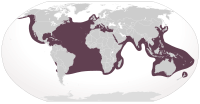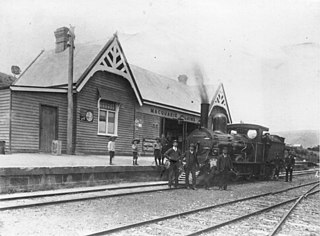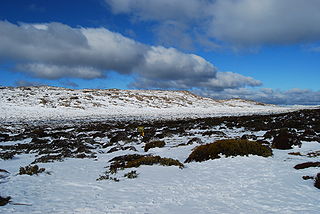
This is a list of reptiles occurring in Tasmania:

This is a list of reptiles occurring in Tasmania:
| Image | Scientific name | Distribution |
|---|---|---|
 | Rankinia diemensis , mountain dragon |  |
 | Bassiana duperreyi , eastern three-lined skink |  |
 | Cyclodomorphus casuarinae , she-oak skink | Tasmania |
 | Egernia whitii , White's skink |  |
 | Eulamprus tympanum , southern water skink | New South Wales, Victoria and Rodondo Island, Tasmania |
 | Lampropholis delicata , delicate skink | Eastern Australia, including Tasmania. Accidentally introduced to New Zealand, Hawaii, and Lord Howe Island. |
 | Lerista bougainvillii , Bougainville's skink | South-eastern Australia, including north-eastern Tasmania |
 | Carinascincus ocellatus , spotted skink | Tasmania |
| Carinascinus microlepidotus , southern snow skink | Tasmania | |
| Carinascinus greeni , alpine cool-skink | Tasmania | |
 | Carinascinus metallicus , metallic skink | Southern Victoria and Tasmania |
| Carinascinus orocryptus , Tasmanian mountain skink | Tasmania | |
| Carinascinus palfreymani , Pedra Branca skink | Pedra Branca, Tasmania | |
 | Pseudomoia entrecasteauxii , southern grass skink |  |
 | Pseudemoia pagenstecheri , southern grass tussock skink |  |
 | Pseudemoia rawlinsoni , glossy grass skink | New South Wales, South Australia, Victoria and Tasmania |
 | Tiliqua nigrolutea , blotched blue-tongued lizard | New South Wales, South Australia, Victoria, Australian Capital Territory, and Tasmania |
| Image | Scientific name | Distribution |
|---|---|---|
 | Austrelaps superbus , lowland copperhead | South-eastern Australia, including Tasmania |
 | Drysdalia coronoides , white-lipped snake | South-eastern Australia, including Tasmania |
 | Hydrophis platurus , yellow-bellied sea snake | Tropics. Reported sightings in colder waters such as California, New Zealand, and Tasmania. |
 | Notechis scutatus , tiger snake | Western Australia, South Australia, Victoria, New South Wales and Tasmania |
| Image | Scientific name | Distribution |
|---|---|---|
 | Caretta caretta , loggerhead sea turtle |  |
 | Chelodina longicollis , eastern-long necked turtle | East Australia, introduced to Tasmania [1] |
 | Chelonia mydas , green sea turtle |  |
 | Dermochelys coriacea , leatherback sea turtle |  |

The River Derwent is a river located in Tasmania, Australia. It is also known by the palawa kani name timtumili minanya. The river rises in the state's Central Highlands at Lake St Clair, and descends more than 700 metres (2,300 ft) over a distance of more than 200 kilometres (120 mi), flowing through Hobart, the state's capital city, before emptying into Storm Bay and flowing into the Tasman Sea. The banks of the Derwent were once covered by forests and occupied by Aboriginal Tasmanians. European settlers farmed the area and during the 20th century many dams were built on its tributaries for the generation of hydro-electricity.

The Tasmanian Government is the democratic administrative authority of the state of Tasmania, Australia. The leader of the party or coalition with the confidence of the House of Assembly, the lower house of the Parliament of Tasmania, is invited by the governor of Tasmania to form government. The head of government is the premier of Tasmania.

Commonwealth v Tasmania was a significant Australian court case, decided in the High Court of Australia on 1 July 1983. The case was a landmark decision in Australian constitutional law, and was a significant moment in the history of conservation in Australia. The case centred on the proposed construction of a hydro-electric dam on the Gordon River in Tasmania, which was supported by the Tasmanian government, but opposed by the Australian federal government and environmental groups.

The eastern bettong, also known as the southern or Tasmanian bettong, is a small, hopping, rat-like mammal native to grassy forests of southeastern Australia and Tasmania. A member of the rat-kangaroo family (Potoroidae), it is active at night and feeds on fungi and plant roots. Like other marsupials, it carries its young in a pouch. The eastern bettong is under pressure by introduced predators and habitat loss. The subspecies on mainland Australia is extinct, but populations of the Tasmanian subspecies have been reintroduced there.

The Clarke Island, part of the Furneaux Group, is an 82-square-kilometre (32 sq mi) island in Bass Strait, south of Cape Barren Island, about 24 kilometres (15 mi) off the northeast coast of Tasmania, Australia. Banks Strait separates the island from Cape Portland on the mainland.
The Mount Lyell Remediation and Research and Demonstration Program was a joint rehabilitation programme between the Supervising Scientist Australia and the Department of Environment and Land Management, Tasmania to clean up the King River, Queen River and Macquarie Harbour.

Tasmania Parks and Wildlife Service is the government body responsible for protected areas of Tasmania on public land, such as national parks, historic sites and regional reserves. Historically it has also had responsibility for managing wildlife, including game.

The Tasmanian Department of Natural Resources and Environment (NRE) is the government department of the Tasmanian Government responsible for supporting primary industry development, the protection of Tasmania's natural environment, effective land and water management and the protection of Tasmania's relative disease and pest free status. NRE's responsibilities also include maintaining the security of land tenure, administration of much of the state's Crown lands and delivery of government services through Service Tasmania.

Deal Island, the largest island of the Kent Group, is a 1,576-hectare (3,890-acre) granite island, located in northern Bass Strait, that lies between the Furneaux Group, north-east of Tasmania, and Wilsons Promontory, in Victoria, Australia.

Australia has many forests of importance due to significant features, despite being one of the driest continents. As of 2009, Australia has approximately 147 million hectares of native forest, which represents about 19% of Australia's land area. The majority of Australia's trees are hardwoods, typically eucalypts, rather than softwoods like pine. While softwoods dominate some native forests, their total area is judged insufficient to constitute a major forest type in Australia's National Forest Inventory. The Forests Australia website provides up-to-date information on Australia's forests. Detailed information on Australia's forests is available from Australia's State of the Forests Reports that are published every five years.
Robbins Island is a 9,900-hectare (24,000-acre) island located in Bass Strait, lying off the northwest coast of Tasmania, Australia. The island, separated from the Tasmanian mainland by a highly tidal area known as Robbins Passage, lies south to the adjacent Walker Island.

Australian Convict Sites is a World Heritage property consisting of 11 remnant penal sites originally built within the British Empire during the 18th and 19th centuries on fertile Australian coastal strips at Sydney, Tasmania, Norfolk Island, and Fremantle; now representing "...the best surviving examples of large-scale convict transportation and the colonial expansion of European powers through the presence and labour of convicts."
This page discusses the rivers and hydrography of the state of Tasmania, Australia.

Gretna is a rural locality in the local government areas (LGA) of Central Highlands and Derwent Valley in the Central and South-east LGA regions of Tasmania. The locality is about 20 kilometres (12 mi) south-east of the town of Hamilton. The 2016 census has a population of 211 for the state suburb of Gretna. It was formerly known as Stony Hut Plains, though the Gretna post office was known as Macquarie Plains for many years. It has a postcode of 7140.

The Tasmanian Central Highlands is an interim Australian bioregion located in central highlands region of Tasmania, comprising 767,849 hectares.

Tasmanian West is an interim Australian bioregion located in the western region of Tasmania, comprising 1,565,077 hectares.

The Tasmanian South East is an interim Australian bioregion located in the south-eastern region of Tasmania, comprising 1,131,822 hectares.

The Tasmanian Southern Ranges is an interim Australian bioregion located in the southern region of Tasmania, comprising 757,228 hectares.

Ben Lomond is an interim Australian bioregion located in the north eastern region of Tasmania, comprising 657,500 hectares.
Vanishing Falls is a ledge waterfall in south-west Tasmania, Australia that drains into a sinkhole. It is located on the Salisbury River within the Southwest National Park.
"Tasmanian Department of Primary Industries, Parks, Water and Environment" . Retrieved 4 May 2014.